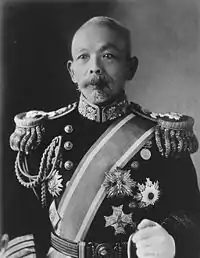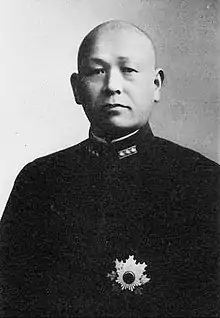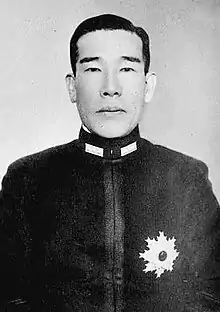Third Fleet (Imperial Japanese Navy)
The 3rd Fleet (第三艦隊, Dai-san Kantai) was a fleet of the Imperial Japanese Navy (IJN), which was created, and subsequently disbanded on six separate occasions and revived on five separate occasions.
History
Russo-Japanese War
First established on 28 December 1903, the 3rd Fleet was created by the Imperial General Headquarters as an administrative unit to manage vessels considered obsolete for front-line combat service. These vessels were used primarily for training and for coastal patrol duties. The 3rd Fleet came under the aegis of the Combined Fleet for the duration of the Russo-Japanese War from March 1904. Although initially derided as a "dinosaur fleet",[1] the 3rd fleet proved invaluable at the Battle of Tsushima and the Invasion of Sakhalin. It was disbanded on 20 December 1905.
South China Fleet
The 3rd Fleet was revived on 24 December 1908 as an expeditionary force during the Chinese Republican Revolution, to safeguard Japanese interests (civilians and property) on the Chinese mainland and (if necessary) to conduct emergency evacuation. It was nicknamed the "South China Fleet" after its chief area of envisioned activity was the South China Sea. Its cruisers patrolled the Yangtze River and other large rivers in China, and its headquarters was in the Japanese concession in Shanghai. It was disbanded on 25 December 1915.
World War I
The 3rd Fleet was reconstituted on the same day as the dissolution of the "South China Fleet", initially to act as a training force to supplement Japan's contribution to the World War I under the terms of the Anglo-Japanese Alliance. When the Russian Revolution was proclaimed by the communist forces in Russia, the mission of the 3rd Fleet was changed to that of patrols of the Russian sea coast for the Siberian Intervention by Japanese ground forces in support of anti-Bolshevik forces. The 3rd Fleet was disbanded on 1 December 1922, and many of its vessels were scrapped almost immediately under the terms of the Washington Naval Treaty.
First China Expeditionary Fleet
The 3rd Fleet was again raised on 2 February 1938 as part of Japan's emergency buildup of forces after the Shanghai Incident. The buildup took the form of three separate expeditionary fleets, consisting primarily of cruisers and gunboats to patrol the Chinese coast and major riverways and to support the landings of Japanese ground forces. With the outbreak of the Second Sino-Japanese War in 1937, the 3rd Fleet came under the aegis of the China Area Fleet. It was disbanded on 15 November 1939; however, some of the organizational and command structures for ground forces under the First China Expeditionary Fleet remained in place until August 1943.
Southern Expeditionary Fleet
The 3rd Fleet was recreated once again on 10 April 1941 with the additional designation "Southern Expeditionary Fleet" for the specific task of invading the Philippine islands. At the time of the attack on Pearl Harbor, its headquarters was in Palau and its mission expanded to include the invasions of Java, Borneo and other islands of the Netherlands East Indies. It was superseded by the 2nd Southern Expeditionary Fleet under the aegis of the Southwest Area Fleet on 10 March 1942.
Order of Battle at time of Pearl Harbor
- Based at Takao, Formosa[2]
12th Carrier Division
- AV Kamikawa Maru (flagship)
- AV Sanuki Maru
- AV Sanyo Maru
16th Division
17th Division
- AN/CM Itsukushima (flagship)
- AN/CM Yaeyama
- CM Tatsumiya Maru
- CM Tatsuharu Maru
Supply Group
- AR Yamabiko Maru
- AP Senko Maru
- AW Koan Maru
- AW Chozan Maru
- AW Goryu Maru
- AO Hayatomo Maru
- AO Genyo Maru
- AP Kosei Maru
- AGS Kyodo Maru
5th Destroyer Squadron
- CL Natori (flagship)
- 5th Destroyer Division
- DD Asakaze
- DD Harukaze
- DD Hatakaze
- DD Mattsukaze
- 22nd Destroyer Division
6th Submarine Squadron
1st Base Force
- 21 Minesweeper Division
- 1st Gunboat Division
- PG Busho Maru
- PG Keiko Maru
- PG Kanko Maru
- PG Myoken Maru
- 1st Subchaser Division
- 2nd Subchaser Division
- 51st Subchaser Division
- 52nd Subchaser Division
- PC Shonan Maru No. 17
- PC Takunan Maru No. 5
- AN Fukuei Maru No. 15
- Other
2nd Base Force
- 21st Torpedo Boat Division
- 11th Minesweeper Division
- AM W-13
- AM W-14
- AM W-15
- AM W-16
- 30th Minesweeper Division
- AM W-17
- AM W-18
- AM W-19
- AM W-20
- 2nd Gunboat Division
- PG Kamitsu Maru
- PG Tokuyo Maru
- PG Taiko Maru
- PM Banyo Maru
- 3rd Gunboat Division
- 53rd Subchaser Division
- PC Kyo Maru No. 2
- PC Kyo Maru No. 11
- AN Korei Maru
- 54th Subchaser Division
- PC Shonan Maru No. 1
- PC Shonan Maru No. 2
- AN Nagara Maru
- 21st Subchaser Division
- 31st Subchaser Division
- PC Ch-10
- PC Ch-11
- PC Ch-12
- Other
32nd Special Base Force
- 1st Patrol Boat Division
- PB Patrol Boat No. 1
- PB Patrol Boat No. 2
- PB Patrol Boat No. 32
- PB Patrol Boat No. 33
- PB Patrol Boat No. 34
- PB Patrol Boat No. 35
- PB Patrol Boat No. 36
- PB Patrol Boat No. 37
- PB Patrol Boat No. 38
- PB Patrol Boat No. 39
- Other
World War II (post-July 1942)
The sixth (and final) incarnation of the 3rd Fleet was formed on 14 July 1942 immediately after the disastrous Battle of Midway as an aircraft carrier task force modeled after similar units in the United States Navy. It was centered on the new aircraft carriers Shōkaku and Zuikaku. It played an important role during the Pyrrhic victory at the Battle of Santa Cruz, in which the American aircraft carrier Hornet was sunk, but at the cost of many of the best air crews in the Japanese Navy.
After March 1944, the 3rd Fleet was basically merged with the 2nd Fleet, and suffered through the disastrous Battle of the Philippine Sea, losing 3 of its aircraft carriers, including the newly commissioned Taihō and over 350 carrier planes.
In October 1944, the 3rd Fleet was designated the "Northern Force" in a three-force plan to defeat the Allied invasion of the Japanese-held Philippines. The 3rd Fleet carriers were divested of all but 108 aircraft and sent to lure the American-led fleet away from protecting the troop landing ships. On 25–26 October, facing a large force that included ten USN carriers, with 600–1,000 aircraft,[3] 3rd Fleet lost 4 aircraft carriers, one light cruiser and one destroyer at the Battle off Cape Engaño. The 3rd Fleet effectively ceased to exist, and was officially disbanded on 15 December 1944.[4]
1st Creation (Russo-Japanese War)
| Commander-in-Chief | Dates | Previous Post | Next Post | Notes | |||
|---|---|---|---|---|---|---|---|
| 1 |  | Vice-Admiral Kataoka Shichirō 片岡七郎 | 28 December 1903 | 20 December 1905 | Commander Takeshiki Naval Base | Commander-in-chief 1st Fleet | |
2nd Creation (World War I)
| Rank | Name | Dates | ||
|---|---|---|---|---|
| 1 | Admiral | Kakuichi Murakami | 13 December 1915 | 6 April 1917 |
| 2 | Admiral | Ryokitsu Arima | 6 April 1917 | 1 December 1918 |
| 3 | Admiral | Teijiro Kuroi | 1 December 1918 | 1 December 1919 |
| 4 | Admiral | Kaneo Nomaguchi | 1 December 1919 | 1 December 1920 |
| 5 | Admiral | Kozaburo Oguri | 1 December 1920 | 1 December 1921 |
| 6 | Admiral | Baron Kantarō Suzuki | 1 December 1921 | 27 July 1922 |
| 7 | Vice-Admiral | Naoe Nakano | 27 July 1922 | 1 December 1922 |
3rd Creation (2nd Sino-Japanese War)
| Commander-in-Chief | Dates | Previous Post | Next Post | Notes | |||
|---|---|---|---|---|---|---|---|
| 1 |  | Vice-Admiral Nomura Kichisaburō 野村吉三郎 | 2 February 1932 | 28 June 1932 | Commander-in-chief Yokosuka Naval District | Commander-in-chief Yokosuka Naval District | Relieved after being blinded in eye during the Hongkou Park bombing 29 April 1932. |
| 2 |  | Vice-Admiral Sakonji Seizō 左近司政三 | 28 June 1932 | 1 December 1932 | Commander-in-chief Sasebo Naval District | ||
| 3 |  | Vice-Admiral Mitsumasa Yonai 米内光政 | 1 December 1932 | 15 September 1933 | Commander Chinkai Guard District | Attendant Navy General Staff | |
| 4 |  | Vice-Admiral Imamura Nobujirō | 15 September 1933 | 15 November 1934 | Commander-in-chief Sasebo Naval District | ||
| 5 |  | Vice-Admiral Hyakutake Gengo 百武源吾 | 15 November 1934 | 1 December 1935 | Commander-in-chief Maizuru Guard District | Commander-in-chief Sasebo Naval District | |
| 6 |  | Vice-Admiral Oikawa Koshirō 及川古志郎 | 1 December 1935 | 1 December 1936 | Director Naval Aviation Bureau | ||
| 7 |  | Admiral Hasegawa Kiyoshi 長谷川清 | 1 December 1936 | 25 April 1938 | Vice-Minister of the Navy | Commander-in-chief Yokosuka Naval District | Also Commander-in-chief China Area Fleet after 20 October 1937 |
| 8 |  | Vice-Admiral Oikawa Koshirō 及川古志郎 | 25 April 1938 | 15 November 1939 | Chief Naval Aviation Bureau | Commander-in-chief China Area Fleet | Also Commander-in-chief China Area Fleet |
On 15 November 1939 the 3rd Fleet was reorganized into the 1st China Expeditionary Fleet.
Admiral Oikawa retained command of the China Area Fleet but command of the former 3rd Fleet passed to Tanimoto Umatarō. Command History continues there.
4th Creation (Pacific War)
| Rank | Name | Dates | ||
|---|---|---|---|---|
| 1 | Admiral | Ibō Takahashi | 10 April 1941 | 10 March 1942 |
| X | Disbanded | 10 March 1942 | 14 July 1942 | |
| 1 | Admiral | Chuichi Nagumo | 14 July 1942 | 11 November 1942 |
| 2 | Vice-Admiral | Jisaburō Ozawa | 11 November 1942 | 15 November 1944 |
Chief of Staff
| Rank | Name | Dates | ||
|---|---|---|---|---|
| 1 | Rear-Admiral | Shizuka Nakamura | 28 December 1903 | 12 January 1905 |
| 2 | Vice-Admiral | Koshi Saito | 12 January 1905 | 2 November 1905 |
| X | Disbanded | 20 December 1905 | 13 December 1915 | |
| 1 | Rear-Admiral | Shichitaro Takagi | 13 December 1915 | 1 April 1916 |
| 2 | Rear-Admiral | Tokutaro Hiraga | 1 April 1916 | 19 March 1917 |
| 3 | Vice-Admiral | Hisatsune Iida | 19 March 1917 | 1 December 1917 |
| 4 | Vice-Admiral | Shichigoro Saito | 1 December 1917 | 1 December 1918 |
| 5 | Vice-Admiral | Shinzaburo Furukawa | 1 December 1918 | 10 June 1919 |
| 6 | Vice-Admiral | Kosaburo Uchida | 10 June 1919 | 20 November 1920 |
| 7 | Rear-Admiral | Hisamori Taguchi | 20 November 1920 | 1 December 1921 |
| 8 | Vice-Admiral | Naomoto Komatsu | 1 December 1921 | 1 December 1922 |
| X | Disbanded | 1 December 1922 | 2 February 1932 | |
| 1 | Admiral | Shigetarō Shimada | 2 February 1932 | 28 June 1932 |
| 2 | Vice-Admiral | Shigeru Kikuno | 28 June 1932 | 1 April 1933 |
| 3 | Rear-Admiral | Seizaburo Mitsui | 1 April 1933 | 15 November 1933 |
| 4 | Admiral | Shirō Takasu | 15 November 1933 | 15 November 1934 |
| 5 | Vice-Admiral | Eijiro Kondo | 15 November 1934 | 2 December 1935 |
| 6 | Vice-Admiral | Seiichi Iwamura | 2 December 1935 | 16 November 1936 |
| 7 | Vice-Admiral | Rokuzo Sugiyama | 16 November 1936 | 25 April 1938 |
| 8 | Vice-Admiral | Jinichi Kusaka | 25 April 1938 | 23 October 1939 |
| 9 | Admiral | Shigeyoshi Inoue | 23 October 1939 | 15 November 1939 |
| X | Disbanded | 15 November 1939 | 10 April 1941 | |
| 1 | Vice-Admiral | Toshihisa Nakamura | 10 April 1941 | 10 March 1942 |
| 2 | Vice-Admiral | Ryunosuke Kusaka | 14 July 1942 | 23 November 1942 |
| 3 | Vice-Admiral | Sadayoshi Yamada | 23 November 1942 | 6 December 1943 |
| 4 | Rear-Admiral | Keizo Komura | 6 December 1943 | 1 October 1944 |
| 5 | Rear-Admiral | Sueo Obayashi | 1 October 1944 | 15 November 1944 |
Notes
- Jukes, The Russo-Japanese War
- Niehorster, Leo; Alsleben, Al; Yoda, Tadashi. "Administrative Order of Battle - 3rd Fleet, Combined Fleet, 7 December 1941". Imperial Japanese Armed Forces.
- Morison, Samuel Eliot (2004) [1956]. Leyte, June 1944 – January 1945, vol. 12 of History of United States Naval Operations in World War II. Champaign, Illinois: University of Illinois Press; Reprint edition. ISBN 0-252-07063-1.
- D'Albas, The Death of a Navy
- Wendel, Axis History Database
References
- D'Albas, Andrieu (1965). Death of a Navy: Japanese Naval Action in World War II. Devin-Adair Pub. ISBN 0-8159-5302-X.
- Dull, Paul S. (1978). A Battle History of the Imperial Japanese Navy, 1941-1945. Naval Institute Press. ISBN 0-87021-097-1.
- Jukes, Geoffry (2002). The Russo-Japanese War 1904-1905. Osprey Essential Histories. ISBN 978-1-84176-446-7.
- Lacroix, Eric; Linton Wells (1997). Japanese Cruisers of the Pacific War. Naval Institute Press. ISBN 0-87021-311-3.
External links
- Nishida, Hiroshi. "Imperial Japanese Navy". Archived from the original on 30 January 2013. Retrieved 25 August 2007.
- Wendel, Marcus. "Axis History Database". Retrieved 25 August 2007.